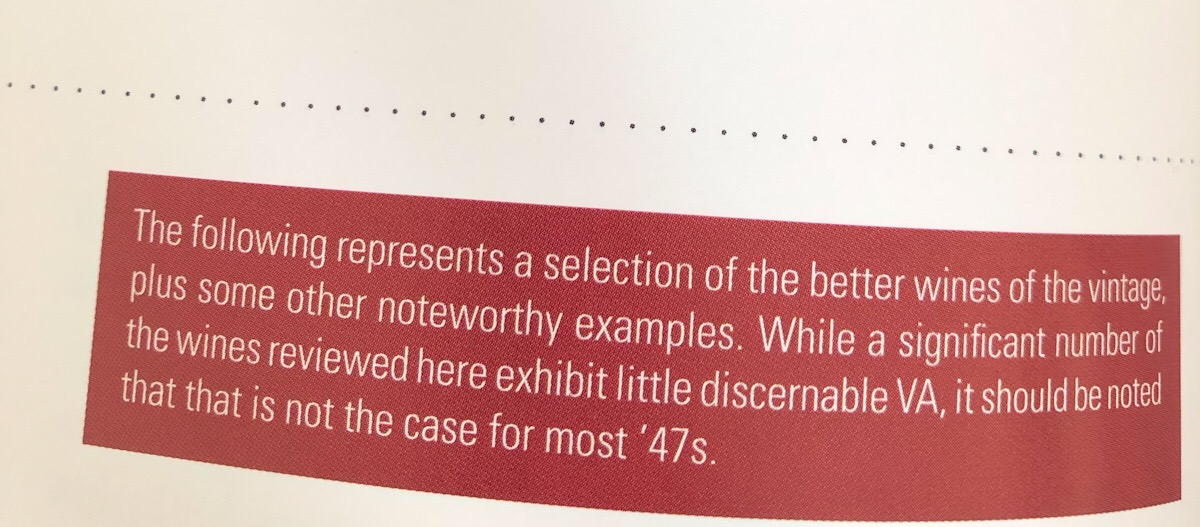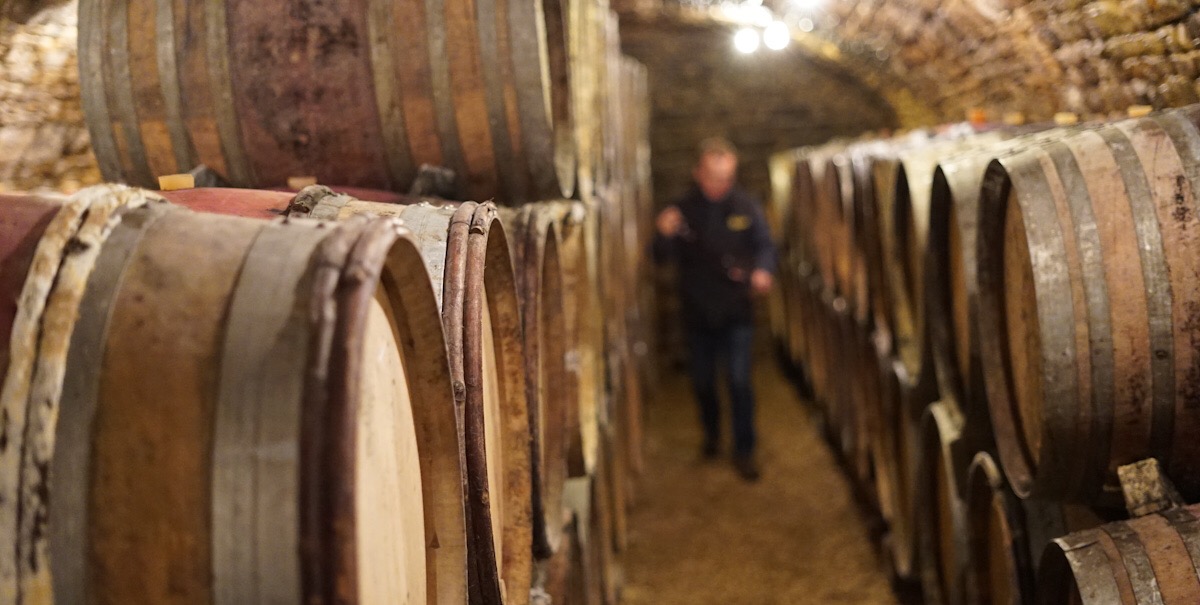The 2018 vintage is by many already getting acclaimed and by some compared to the 1947 vintage … as one of the solar and “great” vintages.
This can seem quite premature, as the wines in some places still are completing the malolactic fermentation.
That being said – it is still interesting to see what we have learned since the last hot vintages – and if this will help us finding the answers about 2018.
The hot years – 1947
No doubt the 1947 vintage was what one could call a rich and hot years … Michael Broadbent writes …
As Broadbent writes “a wonderfully rich vintage”, actually he have tasted his fair share of 1947s – genuine bottles mind you.
As the remark suggest there were however problems due to the heat, as the grapes started to ferment prematurely on the way to the press due to the heat or lack of cooling.
In reality one of the big problems with the 1947 reds were the relatively high level of VA (Volatile Acidity) that are/were found in many wines.
As Meadows and Barzeley writes in “Burgundy Vintages: A history from 1845” .. see below .. the VA is quite a big problem with the 1947.
The hot conditions gave the growers problem with the vinificaton, as cooling facilities were not chosen or available to all producers in 1947.
Looking at Meadows and Barzeley1 they account quite some of the 1947 still in good form, and they are often from the big houses – who presumably (guessing) had good cellars and facilities. Other producers were apparently less satisfied with their 1947s if the cooling of the cellar was less successful. It should be mentioned that 1947 is the birth-year of Douglas Barzeley – hence a large interest and knowledge about this vintage.
A good friend recall that the late Charles Rousseau told about the problems in 1947, and that the cooling of the cellar was an issue. This could perhaps explaining why there is no Rousseau wines on the Meadows and Barzeley 1 list of chosen notes of 1947.
So clearly the cooling of the grapes and the cellar was an important issue in 1947 … and one of the important learnings drawn from this vintage.
Moving forward .. 2003
The 2003 vintage was even hotter and presumably more dramatic than the 1947 vintage, as it sort of caught the vignerons of guard – or if you like on holiday.
Normally the harvest is said to start approximately 100 days after the flowering – but in 2003 this happened already 80 days after the flowering on August 19th.
The harvest was very early, and some growers were more or less still on holiday – and in reality not ready to harvest in time. Most of, or many of the vignerons, were rather unprepared to handle a vintage that early and that hot.
The result were mixed, and I think the growers learned a lot from this experience, and are presumably still learning as the 2003 wines evolve.
The first learning is to plan well ahead – if needed for an early harvest – we are harvesting the benefits from this knowledge now.
In my view there is a before and after 2003 in Burgundy, and from 2003 and onwards there is a greater readiness and precision around harvest dates at most estates. A greater awareness about the optimal harvest dates one could say!
Regarding the harvest date – quite importantly the harvest date influenced the phenolic ripeness – and while sugar was fine, and acidity was already low – the phenolic ripeness was low or insufficient if you like.
The result is quite some wines displaying unripe tannins – one of the big problems with this vintage. The issue was however that growers feared they were facing further drop in acidity if waiting, and some opted to harvest as early as possible.
In reality this was however even more complex as rain in some instances changed the game during the latter part of the harvest.
Another thing was the acidification of the 2003 – clearly not a great ideas in some cases – or perhaps seen from a technical standpoint it should perhaps have been done differently. The winegrowers clearly learned a thing or two about acidification – in my view.
Bottom line 2003 was a tough year for many wine growers, and while many wines are drinkable, I really don’t like the result in most cases … but to say there are no good wines would be pretty steep!
2005 and 2015 hot or not?
It’s debatable if 2005 is a truly hot year, but a rich and powerful year it was and still is.
The leaning from 2005 is less extraction in some cases at least. I have heard quite many producers saying that they tried to extract less in 2015 than in 2005 – meaning that the did feel that they perhaps pushed the extraction a bit too far in 2005.
The result was in some cases very masculine and concentrated wines – wines in the beginning not seeming very Burgundian.
So making the wines more Burgundian is now much more on the agenda – although high extraction was very popular by some in the 1990s – and some should have paid more attention in 1976!!
Bottom line – the 2005 are big wines – but in some if not many cases starting to unfold – even the Burgundian sides. In the end presumably some wines were somewhat overdone.
In my view the 2015s is also a semi-hot vintage, and some wines in some cases clearly are showing quite hot fruit, but the balance is quite often fine for the reds, although perhaps not for fans of über classic Burgundies.
I think we will see the 2015s unfold more freshness than many expected, and while it’s a hot vintage .. I think great wines were made – as in 2005 – as both vintages start to unfold. The whites are somewhat more problematic – yet they are not as problematic as the 2003 – again the harvest was apparently quite well timed given the hot weather.
The 2018s … and what then
It is clear that the frequency of rich or even hot vintages is increasing, and the 2018s sends a reference back to 1947 – according to some.
The winter and spring of 2017/2018 however prevented a 2003 scenario in 2018, as heavy rainfall in the period October 2017 to March 2018 were among the highest in the last 25 years – prevented serious drought during the summer. Furthermore the nights were additionally somewhat cooler that in 2003 – thus another upside for 2018.
Arriving to the harvest 2018 – the question was however .. have we learned something along the way?
The harvest began around August 20th with some early ripening vineyards. I do think that many producers today really are much more precise and analytical, and therefore have timed the harvest better on average – at least more so than in 2003 and 1947.
That being said this was not easy at all, and the great variation in harvest dates does indicate that people were in doubt … or at least seeing the conditions differently.
Tasting the 2018s it is clearly a rich vintage, but apparently not a super solar vintage palate wise, and even the whites can at least currently hide or minimise the solar tendencies ..
It is therefore in my view likely that the growers have done better in the 2018 vintage regarding the timing of the vintage.
VA and other important stuff – in general the knowledge about the anatomy of volatile acidity is now greater, and the therefore the growers are now more careful during the vinification. The possibilities of controlling the vinification are better, hence the risk of getting extensive VA problems are at least in theory reduced.
The acidity … is certainly another matter – and tastings and visits will show if people have acidified or not. Personally I would prefer little or no acidification as this rarely become a harmonious offer – in my experience from the 2003 vintage. That being said I have presumably tasted quite some acidified wines in the 2003 vintage – without being aware of a slight acidification …
Bottom line I really don’t think one can make great wines in Burgundy via acidification – but one can make a hotter and rich wine more bearable or even loveable .. depending on your temper.
The 2018s in an early perspective
I think the vignerons have done a tremendous job in keeping the 2018s on track … much better than it was done in 1947 or 2003.
That being said I remain positive regarding the 2018s and is looking forward to taste more in the fall – or perhaps a few before.
To taste a 1947 in great form in is sadly rare these days … and one should often 20 year back and more to find one of the top end wines from this vintage – so no revival of the 1947s – although I would gladly take a bottle or two to celebrate Douglas Barzeley on his year.
Source:
- Allen D. Meadows and Douglas E. Barzeley: “Burgundy Vintages: A history from 1845




 - A true vin d’émotion – a Burgundy of passion
- A true vin d’émotion – a Burgundy of passion - A truly hedonistic wine – lively and enjoyable
- A truly hedonistic wine – lively and enjoyable - A vivacious wine for pure indulgance
- A vivacious wine for pure indulgance - A potential vin d´émotion - frais et léger
- A potential vin d´émotion - frais et léger